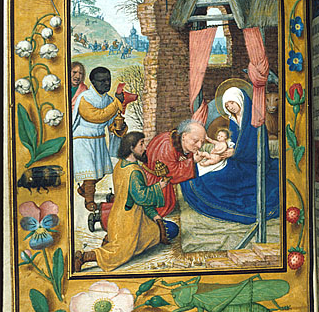As Epiphany approaches, we remember how the Holy Family were visited by three wise men from the East. However they, having foreseen the arrival of the new King of the Jews, had gone to King Herod thinking they would find the infant Christ there. Herod had no knowledge of the birth of a new king, and sadly the revelation of the three wise men would lead to the Massacre of the Innocents. When the magi did find the Holy Family these sages did not, as they had promised, reveal Christ’s whereabouts to Herod. In his endeavour to find and remove any opposition to his rule, Herod ordered every child in his domain under the age of two to be slain. Before this atrocious crime of infanticide could affect them, the Holy Family fled to Egypt, but not before they were visited by the three foreigners who had travelled miles to see the Christ Child.

The Flemish artists have created exquisite illuminations and altarpieces of the Adoration of the Kings. The Montforte altarpiece, now in the Gemaldgalerie, Berlin dates from 1470(ish) and was painted by Hugo van der Goes.
The naturalism of van der Goes shines through from the small details of the backgrounds, where the entourage of the magi are seen waiting while their masters kneel in adoration. The shepherds can also be seen in the far distance through a gap just above the central scene. Look closely and you can see what appears to be an animal running across the beam. This looks to be a stoat in its summer coat. In winter it turns white except for the time of its tail and this is the fur we know as ermine, a symbol of royalty. Its inclusion is twofold and refers to the newborn Child as well as the status of the magi. Unfortunately the original two side panels and part of the top have been lost, which is why you can only see the bottom of the skirts of two angels. Click on this link and it will take you to the page where you can click further and move around the image to see the details. The Montforte Altarpiece c1470 – Hugo van der Goes
There is a great similarity in Jan Gossaert’s Adoration (in London’s National Gallery) to the Montforte altarpiece.
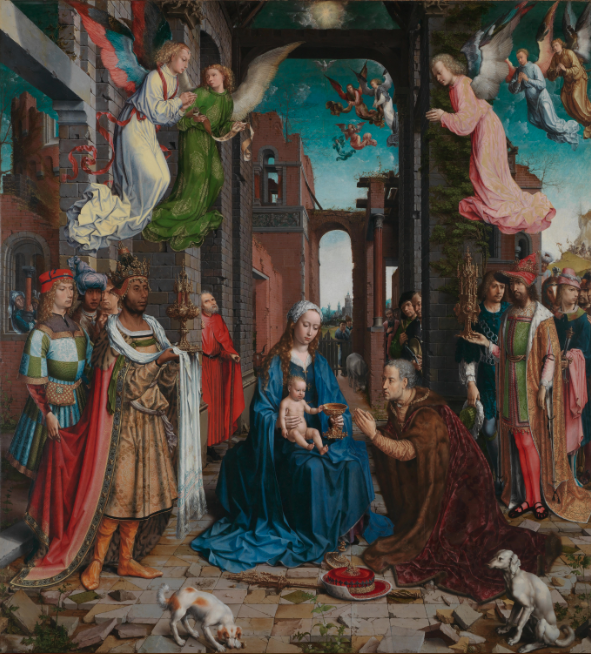
Gossaert (1478-1538) worked for various religious orders and members of the aristocracy, including the Hapsburgs. In 1508–09 Gossaert travelled to Rome perhaps as an ambassador for, or with Philip of Burgundy. Here he was captivated by the Roman statues and is credited with introducing the idea of the nude to a northern european audience. Michelangelo had yet to paint the ceiling of the Sistine Chapel, but Rome was full of nude statues of pagan gods and goddesses. My personal theory is that the colder climate north of the Alps had not lent itself to the development of the subject of nudes in either painting or statuary. You never hear of a nude pagan Norse God, nor a Celtic one either.
In Gossaert’s altarpiece you can see how the angels in van der Goes’s altarpiece would have hovered above the throng in the stable, perhaps holding banners proclaiming the Holy birth. Gossaert has added a white dog which is virtually identical to the one in Dürer’s engraving of the conversion of St Eustace/Hubert (look at the bottom right of the engraving.)
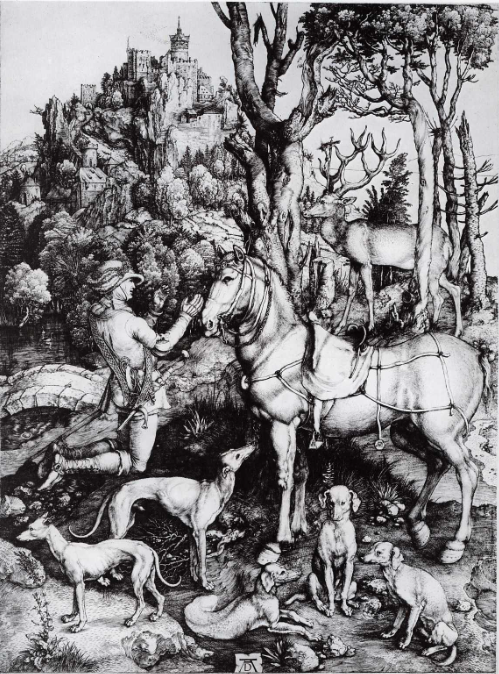
Maryan Ainsworth has proposed this altarpiece is a collaborative work between Jan Gossaert and Gerard David, both working in the Low Countries. Click on the link to explore the altarpiece. Adoration of the Kings – Jan Gossaert National Gallery London
Little is known about Gerard David (1450 -1523), but the National Gallery London has an Adoration of the Magi, attributed to his brush and there are similarities such as the hat and the detailed landscape, but over all it is not as rich as Gossaert’s work.
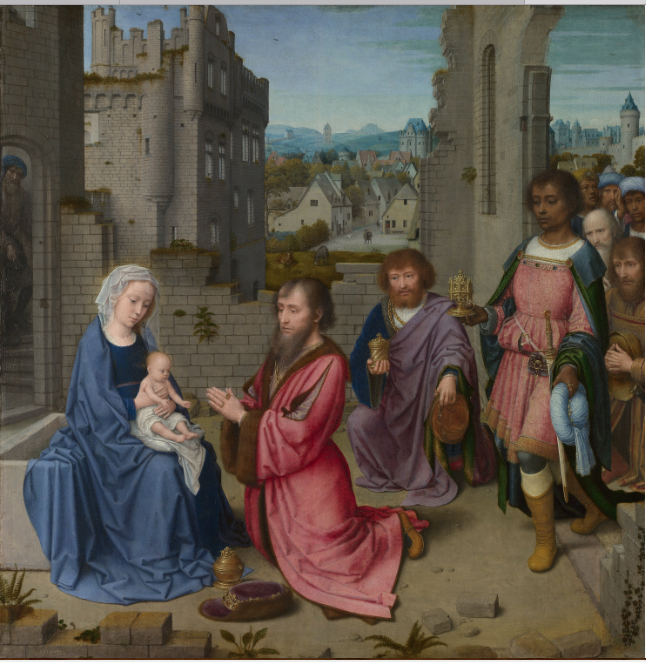
The likelihood for this lack of ‘richness’ may be that the patron commissioning this work did not have the funds for expensive pigments or the inclusion of lots of people to fill the space. Adoration of the Kings 1515-1523 – Gerard David National Gallery London
Today, these well known paintings are able to be seen by the public at any time, either in the museum, or thanks to the wonder of the Internet, online from anywhere in the world. What are less well known are the images in illuminated manuscripts. Many years ago I came across this Adoration (below) in a manuscript in the British Library. Egerton 2125 is a prayerbook illuminated by Simon Bening in 1515 for Joanna of Gistelles, Abbess of the Benedictine Abbey of Messines. Folio 182r is a full page illumination of the Adoration.
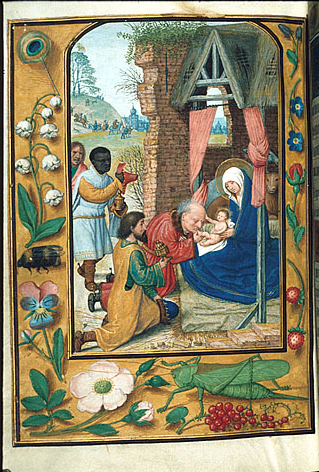
Clearly the illuminations in this manuscript are not all from the same brush and were created by Bening and other members of his workshop, which probably also included his father, Alexander. The grey haired mage kisses the foot of Christ and Joseph is nowhere in sight, unless he is the man just in view behind Balthazar. The action is framed by a painted margin that contains symbols of Mary – the red and white roses; strawberries are symbols of the Trinity, redcurrants of the blood to be shed by Christ; a tri-coloured pansy which appears in many illuminations credited to this workshop; a peackock’s feather – a royal bird.
More importantly, this margin contains a bee and a cricket. Ever since Aristotle it had been thought that bees were male and the head of the hive therefore a king. It was not until 1609 that an amateur entymologist called Charles Butler acknowledged that bees were a matriarchy in his book The Feminine Monarchy. The Bumblebeeconservation.org has suggested this bee is very similar to the queen of the English buff tailed bumble bee (Bombus Terrestris) https://www.bumblebeeconservation.org/white-tailed-bumblebees/buff-tailed-bumblebee/ The bumble bee conservation people are a UK based charity so were not able to comment on any European bee since this illumination was created in Bruges. However, the Bombus terrestris appears to be a widely distributed bumble bee (according to Wikipedia !) Clearly the Bening workshop have included the bee for a reason.
Likewise, the green bush cricket included in the bas de page is not male. Female crickets are recognised by the ovipositor (that is the spikey bit that looks like a tail). However, the close observation showing the wings are slightly shorter than the ovipositor by whoever painted the images in the margin suggests this cricket could be the female of a related species – Tettigonia Cantans – a variety of bush cricket
If you click on the link to the Egerton Adoration and then click on the image (Egerton Ms 2125 – folio 182v) you will be able to see the details of the whole page in full screen. Look closely at the head and the back of the painted cricket you will see there is a very slim brown line down the centre of the head and an isosceles triangle of brown colouration on the cricket’s back. Even the antennae are brown as in the photograph of the female of this species of bush cricket. They are widespread, being found from Europe right across to China and Japan.
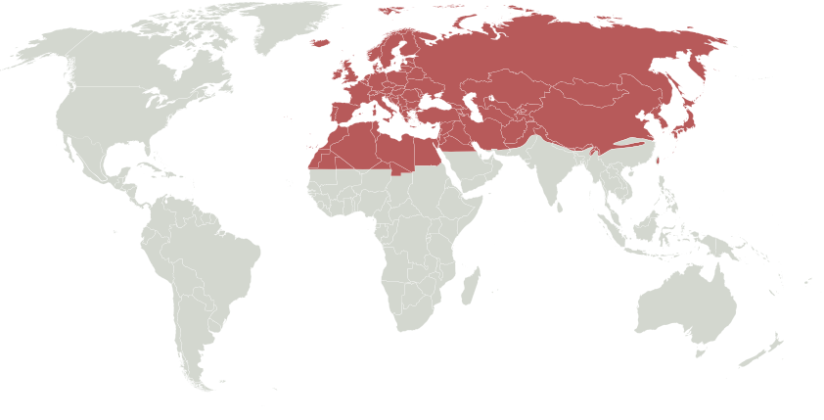
Why this cricket is included here is unknown, unless the artist thought that it was, like the bee, a male. At this time it is likely that no one had any idea the ovipositor was in fact a tube for laying eggs and not the male organ for inseminating female crickets.
Since this illuminated manuscript pre-dates Butler’s acknowledgement that bee colonies were matriarchies by nearly a hundred years, and the probable misconception that this cricket is male, it is apparent is that the artists were still adhering to Aristotelian concepts. That error does not devalue their work. On the contrary, it demonstrates how science was beginning to inform art even though the artists did not have the correct knowledge. It is likely they were working from dead specimens so were unable to observe the mating behaviour of either insect. Alberti’s desire that “art imitateth nature” (1435) is clearly being followed in the rendition of both flora and fauna of these Flemish artists.
To return to the Christmas story.
After the three kings left the stable, having given their gifts of gold, frankincense and myrrh, they made their way back to their own country, but by a different route and the Holy Family fled to safety into Egypt.
The Star-Song: A Carol to the King; Sung at White-Hall
[KING 1] Tell us, thou clear and heavenly tongue, Where is the Babe but lately sprung? Lies He the lily-banks among?
[KING 2] Or say, if this new birth of ours Sleeps, laid within some ark of flowers, Spangled with dew-light; thou canst clear All doubts, and manifest the where.
[KING 3] Declare to us, bright star, if we shall seek Him in the morning’s blushing cheek, Or search the beds of spices through, To find Him out?
[STAR] No, this ye need not do; But only come, and see Him rest A princely Babe in’s mother’s breast.
[CHORUS] He’s seen, He’s seen, why then a round, Let’s kiss the sweet and holy ground; And all rejoice, that we have found A King, before conception crowned.
[3 KINGS together] Come then, come then, and let us bring Unto our pretty Twelfth-tide King, Each one his several offering;
[CHORUS] And when night comes, we’ll give Him wassailing: And that His treble honors may be seen, We’ll choose Him King, and make His mother Queen.
Robert Herrick (1591-1674)
Wishing everyone a joyous and healthy 2019.
Further links
https://www.poetryfoundation.org/poets/robert-herrick
© MVT January 2019.
